

The Atari 260/520/1040 ST
|
The first Atari
ST computers became available to the public in 1985. The new Atari models
where the first 16-bit computers well-suited for use in the home. The
availability of these computers signaled the end of the Atari 8-bit era of
computers such as the 400, 800, 800XL, 1200XL, 1450XLD, 65XE, and 130XE
computers.
The name "ST" is derived from the capabilities of the
Motorola MC68000
processor upon which the original Atari line was based. The MC68000 uses a
Sixteen bit data bus with a Thirty-two bit address bus.
The 16-bit computers introduced a new concept in computer technology
called the Operating System (OS). Atari's operating system, The Operating
System (TOS), was loaded from a boot disk originally, but is now almost
always installed in ROM.
A primary subsystem of TOS is GEM ("Graphics Environment
Manager"), the graphical user interface used by Atari computers. GEM,
which was developed by Digital Research Inc., manages the graphic interface
to applications and provides access to popular computing features with
buzzwords such as windows, the mouse, menus, and the desktop.
GEM was originally designed for PC-compatible computers.
PC-based GEM, however is no longer completely compatible with Atari
GEM.
Other TOS subsystems include GEMDOS, the BIOS ("Basic
Input/Output System"), and the XBIOS ("eXtended Basic Input/Output
System). These subsystems provide a hardware interface and management
functions for the file system.
The original ST computers featured the following:
- Integrated GEM/TOS operating system.
- Motorola MC68000 16/32-bit processor running at 8MHz.
- RAM memory storage of 256k, 512k, or 1Mb (depending on model).
- Integrated video controller capable of generating (320x200x16), (640x200x4), and (640x400x2) video modes from as many as 512 colors.
- Yamaha 3-voice FM sound generator.
- Sophisticated DMA peripheral access.
- External 128k cartridge port.
- Built-in MIDI, two joystick ports, 720k floppy drive, ACSI, serial, and parallel ports.
|
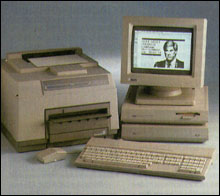
The Atari Mega ST 2/4
|
TTwo years after the release of the original
ST series Atari released the Mega ST series of
computers. The Mega ST computers were shipped with TOS v1.02 and
featured several new features as follows:
- Separate keyboard and CPU.
- BLiTTER chip (for faster graphics).
- Peripheral co-processor slot (for MC68881 math co-processor, etc.).
- Internal expansion bus.
- Either two or four megabytes of RAM.
|
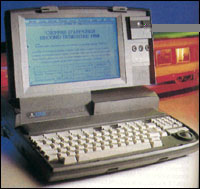
The Atari Stacy
|
The STacy was released shortly after the
Mega ST to provide a portable means of Atari
computing. STacy computers were shipped with TOS v1.04. The STacy's
design supplemented the basic features of an ST
with the following:
- Integrated CPU, keyboard and carrying case.
- Track ball for mouse control.
- Optional hard drive.
- Monochrome LCD screen.
|

The Atari 520/1040 STe
|
The STe, released in 1990, was designed to expand
upon the capabilities of the ST. Many of the
features added were geared towards entertainment and multimedia applications.
The STe was shipped originally with TOS v1.06. The following features
were added to those of the basic ST:
- BLiTTER chip (for faster graphics).
- 256k Operating System in ROM.
- SIMM memory slots to upgrade memory to 4Mb.
- Extended color palette to support up to 4096 colors.
- Support for horizontal and vertical fine scrolling.
- Video GENLOCK capability.
- Stereo 8-bit PCM sound.
- Stereo RCA jacks for sound output.
- Two extended joystick ports with support for paddles and light pens.
|
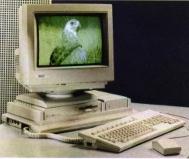
The Atari Mega STe
|
Rreleased in 1990, the Mega STe was designed to
provide far more computing power than the 520/1040
STe and add several new hardware features. The
Mega STe shipped with TOS v2.02, v2.05, or v2.06. It adds features to
that of a 520/1040 STe as follows:
- Modern case design with separate keyboard and CPU.
- Motorola MC68000 16/32-bit processor running at 8MHz or 16MHz.
- Optional Motorola MC68881 math co-processor.
- One, two or four megabytes of RAM memory.
- Optional internal SCSI hard drive.
- Three serial ports (one shared with the LAN).
- Localtalk compatible networking port.
- VME compatible expansion slot.
- New 14 inch SM146 monitor.
|

The Atari TT030
|
Aalso released in 1990, the TT030 computer was the
first Atari computer workstation designed for high-end computer users. The
TT030 workstation was shipped with TOS v3.01, v3.05, or v3.06. It adds
the following features to that of the
MegaSTe:
- Motorola MC68030 32-bit processor running at 32MHz.
- Motorola MC68882 math co-processor.
- Memory capacity of 32Mb with optional "FAST-RAM".
- Extra video resolutions of (320x480x256), (640x480x16), and (1280x960x2).
- Four serial ports.
- SCSI device port.
- New Hi-Res 19" mono monitor.
|
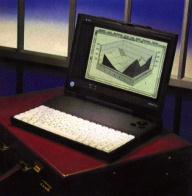
The Atari ST Book
|
Designed to replace the
STacy as the defacto portable
ST computer, the ST Book brought the basic
computing power of an ST to a lightweight notebook
computer. This machine was only released in Europe and Atari only shipped a
very small quantity. The ST Book was shipped with TOS v2.06. Minus the
internal floppy drive, it supported features beyond that of a
STacy as follows:
- Lightweight case design.
- Keyboard with integrated numeric keypad.
- Mouse "vector" pad.
- Processor-direct expansion slot.
- External keyboard port.
- Floppy drive connector.
|
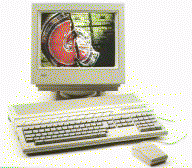
The Atari Falcon030
|
The newest member of the Atari line, the Falcon030
is to become the new base model Atari system. The Falcon030 is currently
shipping with TOS v4.04. While remaining backwardly-compatible, the
Falcon030 adds many new features as follows:
- Integrated case and keyboard design.
- Motorola MC68030 processor running at 16MHz.
- Motorola DSP56001 processor with 96k RAM running at 32MHz.
- Optional Motorola MC68882 math co-processor.
- Interior processor expansion port.
- Standard configurations with 1, 4, or 14Mb RAM.
- Optional internal 2.5" IDE hard drive.
- Video resolutions from 320x200 to 640x480 with a palette from 2 to 256
colors and 16-bit true color.
- Programmable Video chip for even larger non-standard resolutions.
- Adaptable to Atari monitors, standard VGA monitors, and composite video.
- GENLOCK-ready design.
- Sound system includes standard Yamaha FM chip, connection matrix, and
8-track, 16-bit stereo record/playback.
- Ports include parallel, serial, SCSI-2, LAN, four joystick (two extended),
MIDI in/out, microphone, headphone, DSP, and ST compatible cartridge port.
|
Updates
YesCREW
YC Products
MiNT
(c) Copyright MCMXCVI - MMXVI by YesCREW









